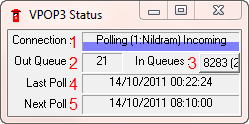Sidebar
Table of Contents
How to use the VPOP3 Status Monitor
The VPOP3 Status Monitor is a small program which displays a postbox icon (usually red) in the Windows notification area (usually at the bottom right of the screen - by the clock). This icon can be used for quick access to various VPOP3 facilities. Note that the Status Monitor is not a required part of VPOP3, and it is quite possible for VPOP3 to be running perfectly without the Status Monitor running (and thus with no icon).
The Status Monitor logs into VPOP3 as a user, so different users can have different permissions - eg logging in as an administrator may give you permission to trigger connections and shutdown/restart the server. Logging in as a normal user may only give you permission to view the current status. Permissions can be set by the VPOP3 administrator.
If the Status Monitor icon has a cross through it, it means that the Status Monitor has not been able to connect to the VPOP3 server.
Status Window
If you double-click the Status Monitor icon when it is connected to the VPOP3 server, it will display the status window.
The status window has two modes:
- The first shows the current connection state, when it last connected to send/collect mail, when it will next connect, and how many messages are waiting to be sent out, and in the logged-in user's Inbox folder.
- The second shows the above information, plus an activity log of what VPOP3 is doing on the Internet at the moment. It will not show local use, but will show incoming and outgoing messages.
To switch between the two modes, either double-click on the title bar of the status window (where it says VPOP3 Status) or right-click anywhere in the window and choose 'Show Activity Log'. This activity log can be very useful for diagnosing simple problems.
Basic View
 This is the basic view mode.
This is the basic view mode.
- The current connection status. Note that 'idle' or 'offline' does not indicate a problem with VPOP3, just that it is not at this moment actively sending or collecting mail. The green progress bar on the top shows the POP3 collection status. The bottom may show a blue bar which is either a SMTP Relay send progress bar, or red SMTP Direct session count bar (SMTP Direct is harder to have a progress bar, so it shows how many active SMTP Direct threads there currently are). The connection status may have a background colour as well. If this is red then it means that the last connection poll totally failed, and nothing was sent or received. If it is Orange then it means that the last connection poll partially failed, so messages were either sent or received, but there were still problems. If there were errors, then the main administrator will have received error message(s) with more information.
- The number of messages waiting to be sent out. If there is a number in parentheses - eg
21 (2)then it means that that is how many messages are in the out queue, but currently 'held' (in this example there would be two held messages). Held messages will not be sent out until they are un-held. - The number of messages waiting in the relevant 'Inbox' folder(s). The status monitor can be configured to show either the Inbox count for the user who has logged into the status monitor, or the total Inbox count for all users. Note that this doesn't show unread messages, just the messages currently in the Inbox folder. Again, if there is a number in parentheses, this shows how many messages are 'held'. Held messages are invisible to the email client.
- The Last Poll time is the time that VPOP3 last completed a connection poll
- The Next Poll time is the time when VPOP3 will last attempt a connection poll.
Activity log View
This is the same as the basic view, but also includes a text list of what VPOP3 is currently doing when sending/receiving mail. If the status monitor is currently showing the basic view, you can get to the activity log mode by either double-clicking on the title bar of the status window (where it says VPOP3 Status) or right-clicking anywhere in the window and choose 'Show Activity Log'.
To save space, the list does not contain time details, but you can right-click on a line to see the date/time when the line was logged, as well as the full line text if there isn't space in the normal view.
